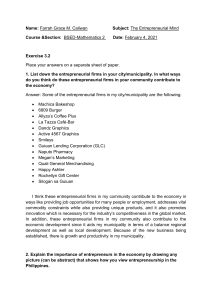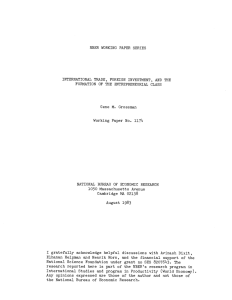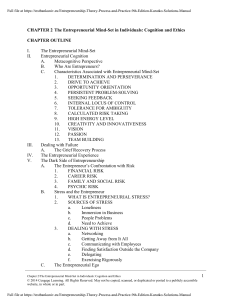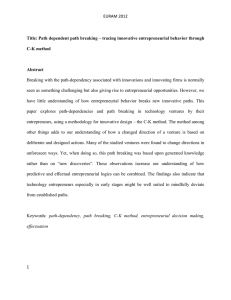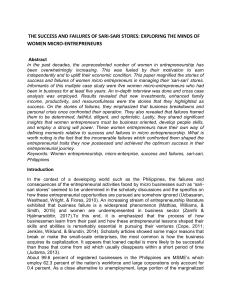SMALL BUSINESS MANAGEMENT Chapter 2 The Small Business Decision
advertisement
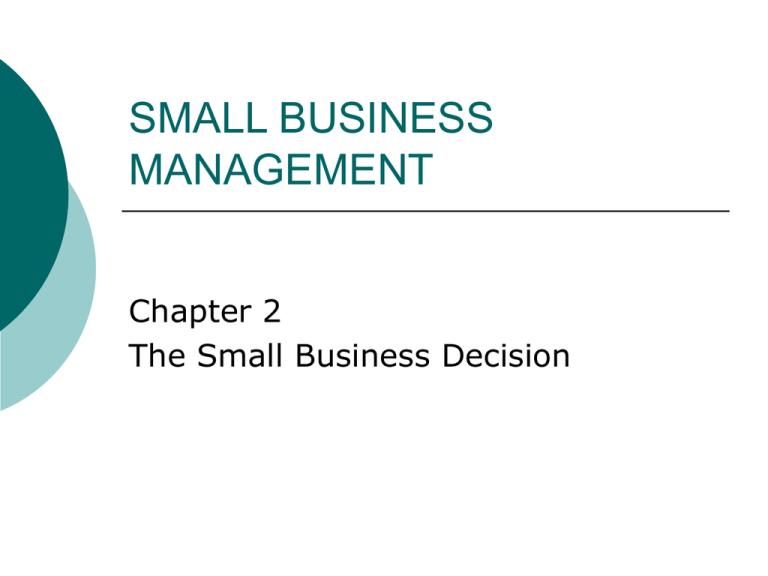
SMALL BUSINESS MANAGEMENT Chapter 2 The Small Business Decision CHAPTER OBJECTIVES 1. To discuss the ___________ and disadvantages of small business ownership as a starting point in making the small business decision. 2. To review the personal and organizational attributes of a successful small business owner. 3. To explain the reasons some ___________ succeed and others fail. 4. To discuss entrepreneurial development in large business. 5. To identify the differences between an ___________ and a manager. The Small Business Decision Personal Evaluation Self evaluation exercise Advantages of Small Business Ownership More personal ___________ with people Independence Skill ___________ Potential ___________ Rewards Challenge ___________ Disadvantages of Small Business Ownership Risk ___________ Need for Many Abilities Limited Financial Rewards People ___________ Time Demands Entrepreneur Defined A person who ___________ and/or operates a business. All active owner-managers and second generation ___________ of family owned firms and owner-managers which buy out founders of existing firms. Also includes ___________ managers of larger corporations who have a flair for innovation and risk. Demographic Characteristics of Entrepreneurs Parents ___________ business Foreign parents High school degree or less ___________ or more Age 31 and under ___________ 40 or more Personality Characteristics Required by Successful Entrepreneurs Achievement Orientation Risk Taking Independence, Self ___________, Self Assurance Innovativeness Strong Verbal and ___________ Skills Selling Skills Personality Characteristics Required by Successful Entrepreneurs (cont) Problem ___________ Abilities Strategic Planning ___________ The Small Business Decision Organizational Evaluation Small Business Successes Alertness to ___________ Ability to ___________ and Hold Competent Employees Staying ___________ to the Consumer Small Business Successes Thoroughness with Operating Details Ability to Obtain Needed Capital Effective Handling of Laws, Rules, and Regulations Small Business Successes Entrepreneurial Success in a Large Business Ten Commandments for Intrapreneur Success Small Business Failures Bankruptcies Entrepreneurialship and Small Business Management Entrepreneurial Skills Characteristics creativity, ___________, independence, risk-taking, idea oriented Situations generating ideas and solutions to problems, starting a new business, expanding or opening new products Characteristics of Artisan Entrepreneurs ___________ ___________ approach Technical Reluctance to delegate Narrow view of strategy Personal sales effort Short ___________ horizon Simple record keeping Characteristics of Opportunistic ( Promoter) Entrepreneurs Broad-based education Scientific approach to problems to ___________ Broad view of strategy Willing Diversified Longer ___________ approach planning horizon Sophisticated accounting and financial control Entrepreneurialship and Small Business Management Managerial Skills Characteristics develops ___________ and goal setting, prefers to know outcomes of actions or activities, team player, works through others, skills in finance, marketing, personnel, operations Situations reaching ___________ objectives, maintaining control of operations Bright Lights, Deep Waters Discuss the difference between an entrepreneur and a manager using David Green and Carmanah Lights as examples. What dangers of obtaining equity financing are illustrated in this example? Concept Checks 1. List the advantages of owning a small business. 2. List the disadvantages of owning a small business. 3. What are the characteristics of successful small business owners? Concept Checks 4. What are the major cases of business failure? 5. What is the difference between an entrepreneur and a manager?
